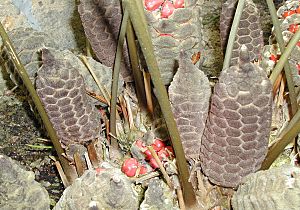Guáyara facts for kids
Quick facts for kids Guáyara |
|
|---|---|
 |
|
| Conservation status | |
| Scientific classification | |
| Genus: |
Zamia
|
| Species: |
pumila
|
The Zamia pumila, often called guáyara in Spanish, is a small, tough plant. It is a type of cycad, which are ancient plants that look a bit like palms or ferns. This plant grows naturally in the Greater Antilles, a group of islands in the Caribbean Sea.
Zamia pumila was the first species of its kind ever described. Because of this, it is known as the type species for the whole Zamia group and the Zamiaceae plant family.
Contents
About Zamia pumila
This plant has reddish seed cones with a pointy tip. Its leaves can be quite long, from about 60 to 120 centimeters (2 to 4 feet). Each leaf has 5 to 30 pairs of smaller leaflets. These leaflets are usually long and narrow, about 8 to 25 cm (3 to 10 inches) long and 0.5 to 2 cm (0.2 to 0.8 inches) wide. They often have small teeth at their tips. The edges of the leaflets can be rolled under, and their stems can be prickly.
Zamia pumila is similar to other cycads like Z. furfuracea and Z. integrifolia. However, it usually has slightly narrower leaflets than Z. furfuracea. Z. integrifolia often has leaflets with smooth edges, or only very slight teeth.
This plant usually grows low to the ground. Its main stem, or trunk, can be 3 to 25 cm (1 to 10 inches) tall and wide. Often, this trunk grows mostly underground. Over time, it can form a group of many branches. It also has a large, thick root system that is actually part of its underground stems.
How Zamia pumila Reproduces
Like other cycads, Z. pumila is a dioecious plant. This means there are separate male plants and female plants.
Male plants produce cylindrical cones that are 3 to 15 cm (1 to 6 inches) long. These male cones often grow in clusters. Female plants produce cones that are more oval-shaped. They grow to 6 to 15 cm (2.5 to 6 inches) long and 4 to 6 cm (1.5 to 2.5 inches) wide.
Pollination happens with the help of certain insects. A special type of cycad weevil, called Rhopalotria slossoni, helps carry pollen from the male cones to the female cones.
Where Zamia pumila Lives
Zamia pumila can be found in many different places. It likes soils that drain water well, such as sandy soils. It also prefers sunlight that is filtered or partial shade, rather than full, direct sun.
Today, this plant is known to grow in central Cuba, southern Puerto Rico, and the Dominican Republic. It used to live in Haiti as well. However, it might have disappeared from Haiti because of a lot of land being used for farming and other activities. In Puerto Rico, the number of these plants has gone down because land was cleared for raising cattle.
Plant Ecology and Uses
This plant is poisonous. It makes a natural toxin called cycasin. This toxin can affect the stomach and intestines, and also the nervous system.
However, people have found ways to use the plant. The Taíno people, who were the original inhabitants of the Caribbean, carefully removed the toxin. They would then use the roots and underground stems to get a type of starch.
Various insects also interact with this plant. For example, the Atala butterfly (Eumaeus atala) eats Z. pumila. This butterfly can store the plant's toxin inside its own body. This helps the butterfly protect itself from predators.
See also
 In Spanish: Zamia pumila para niños
In Spanish: Zamia pumila para niños


